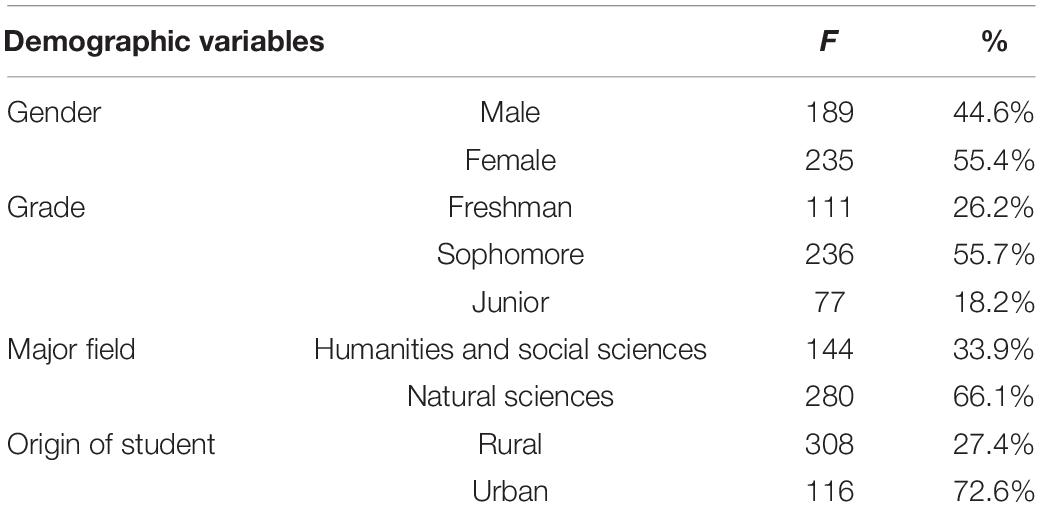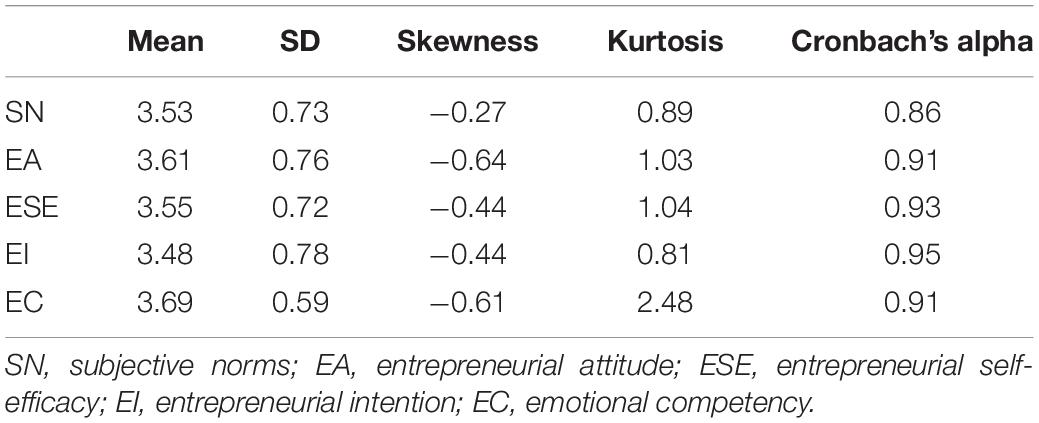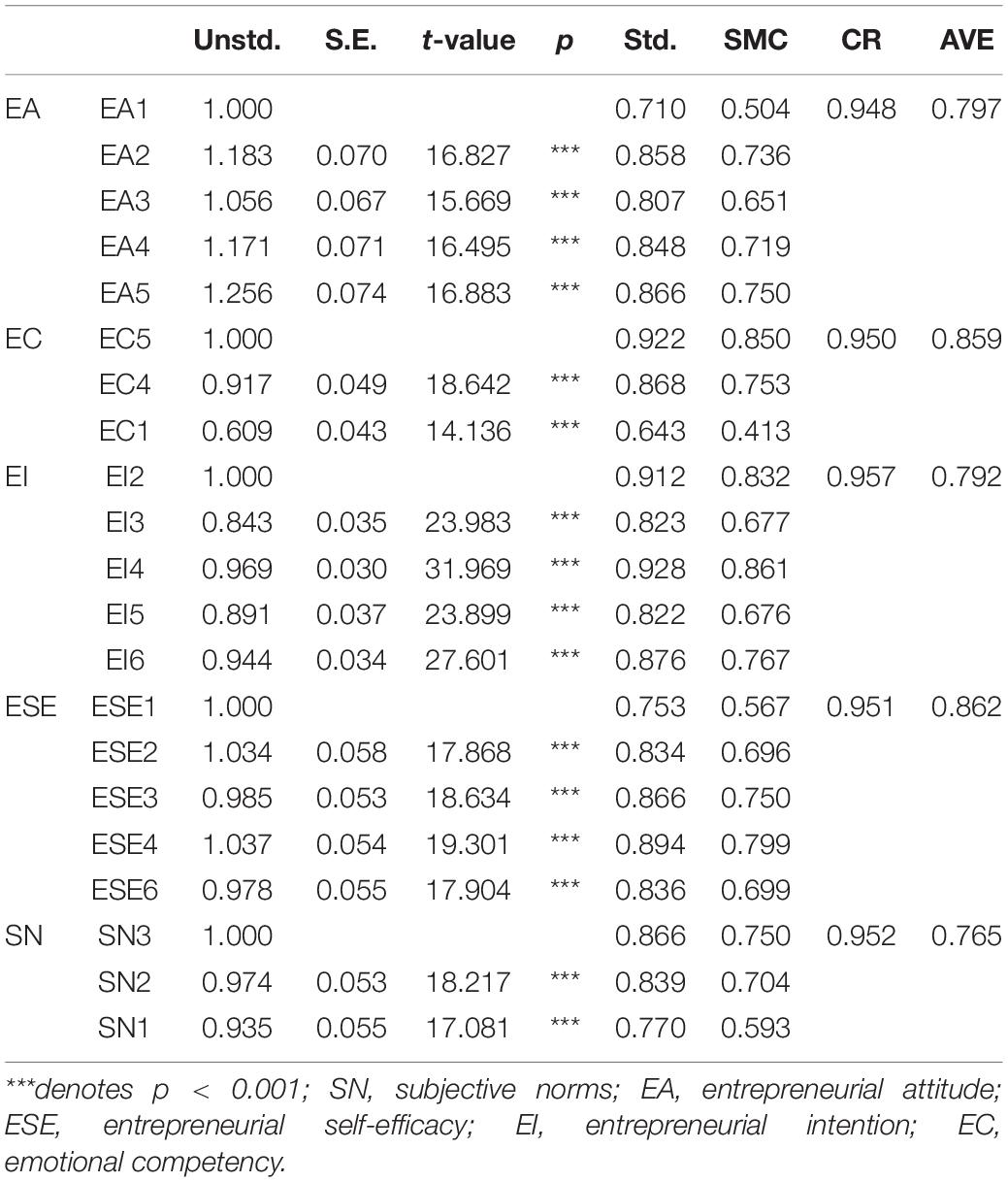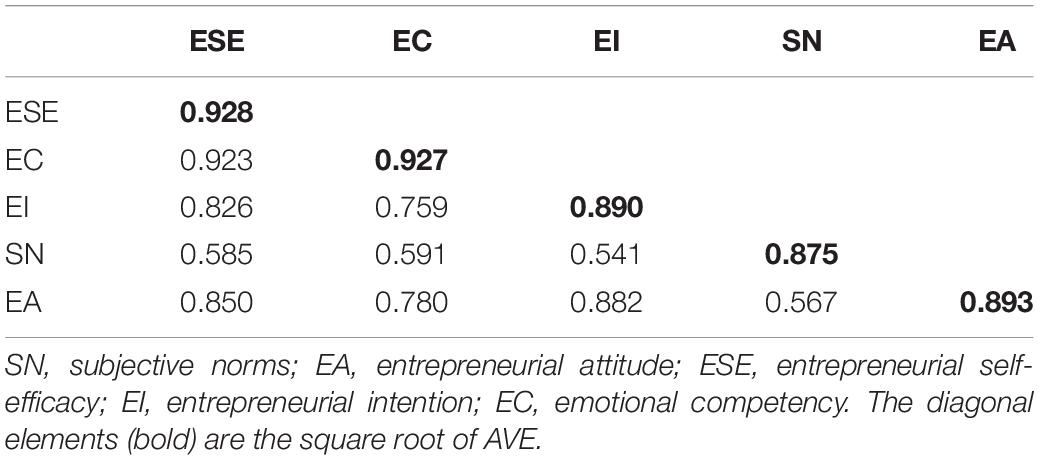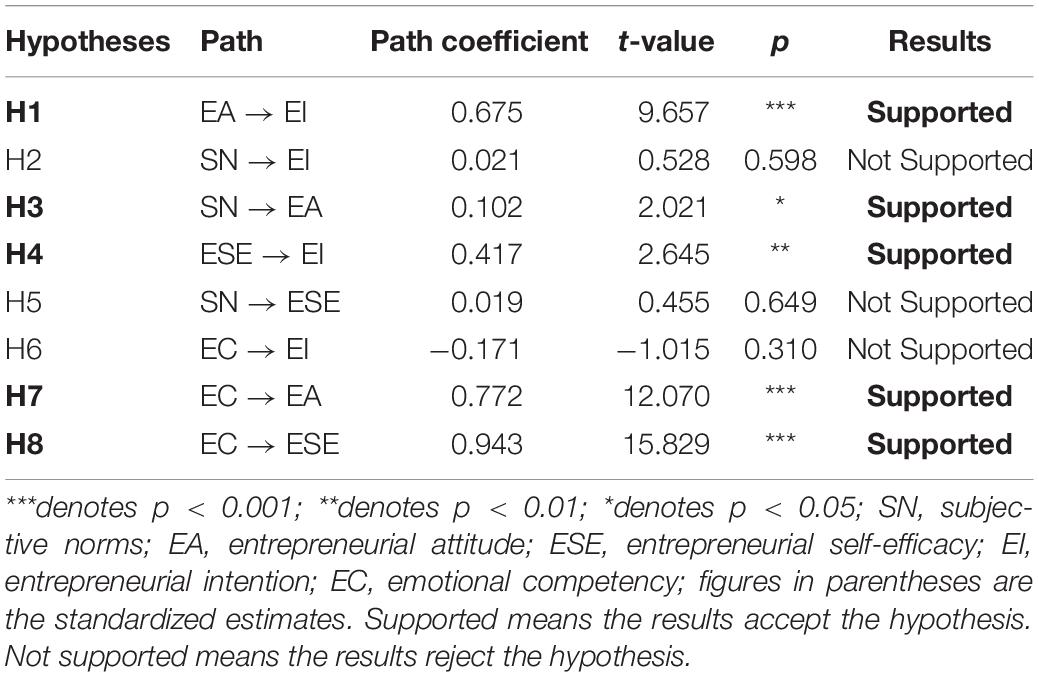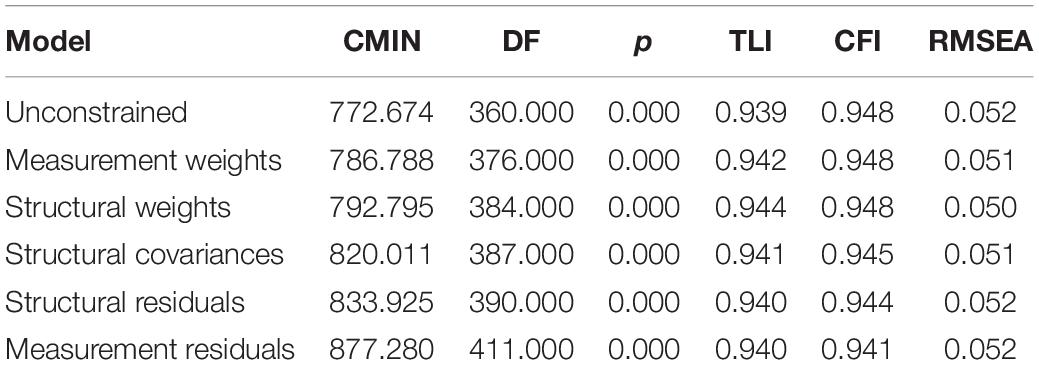- School of Education, Jiangxi Science and Technology Normal University, Nanchang, China
The purpose of this work is to investigate the major drivers behind the entrepreneurial intention (EI) of students from higher vocational colleges in China. Total 424 respondents participated in the survey questionnaire that measured their self-reported responses to five constructs (EI, entrepreneurial self-efficacy, emotional competencies, subjective norms, and entrepreneurial attitude). In addition to this, the equation modeling technique was used to perform the data analysis. The study results highlighted that both entrepreneurial self-efficacy and entrepreneurial attitudes serve as significant predictors of EI. Moreover, the entrepreneurial attitude was found to be a significant mediator of the EI and emotional competencies. Finally, a model invariance was established across the female and male student samples. As a result, this study has put forward some implications regarding the entrepreneurship education of the higher vocational students in China.
Introduction
The global spread of COVID-19 will have profound implications for the world economy, especially in terms of jobs and economic growth. In the process of economic development, entrepreneurial activities play a vital role. Vigorous entrepreneurial activities will not only create more jobs, protect people’s livelihood, and improve the sustainability of career development, but also accelerate the commercial application of new knowledge and technologies and help the economy achieve innovation-driven and high-quality development (Nowiński et al., 2019). Since 2014, the Chinese government calls for “mass entrepreneurship and innovation” and “optimizing the environment and providing uninterrupted services to increase the proportion of the college students’ employment and entrepreneurship,” to realize the sustainable development of college students’ career ability.
In China, there are two main types of college graduates: general higher education graduates and higher vocational education graduates. According to data from the National Bureau of Statistics of China, the ratio of the scale of vocational education to the scale of general education in 2020 is about 1:1, and its importance is self-evident (National Bureau of Statistics, 2019). However, ordinary higher education graduates are much higher than the entrepreneurial rate of vocational college graduates, and the ratio is 28%:2% (National Institute Of Education Sciences, 2020; Renmin University of China, 2020). Therefore, the study of entrepreneurial in higher vocational colleges is of great value to improving employment quality and national economy.
Entrepreneurship is so important that scholars have begun to explore what are the key factors that drive individuals to become entrepreneurs. It has also made the scholars investigate the factors that contribute to the initial entrepreneurial behavior of the entrepreneurs. According to Ajzen (1991), behavior performance is affected by all those factors that can indirectly affect human behavior, although, intentions control the human actions as humans do not execute all of their intentions (Ajzen, 1985). Furthermore, several research studies have acknowledged the significance of the entrepreneurial intention (EI). For instance, Krueger et al. (2000) reported that reflexive behavior does not drive entrepreneurial behavior, but it is rather intentional in nature. Similarly, Cai and Zhao (2014) stated that only those people can effectively carry out entrepreneurial activities who have strong EI. EI is one of the important factors that contribute to entrepreneurial behavior whereas EI is rare, but such intentions retain for a longer period of time (Noel, 2002). Lüthje and Franke (2003) advocate that the entrepreneurial behavior of the person is significantly determined by EI. Many studies have investigated the influencing factors of EI from different perspectives. Among previous research models, Theory of Planned Behavior (TPB) has the greatest influence. TPB model has been widely concerned and applied in various research fields, especially in the fields of social science, life science and entrepreneurial management, providing a simple model of the main determinants of individual behavior. In order to enhance the predictive ability of TPB model in higher vocational college students’ entrepreneurial behavior, it is very important to explore other important potential variables through further research. Especially since the proximal variables have been well documented, EI studies need to include other novel predictors. At present, some studies on the influencing factors of students’ EI based on TPB model have been mentioned in academic entrepreneurship literature at home and abroad, but their analysis conclusions are different. Therefore, it is of great significance to expand TPB and study the EI of vocational college students and its influencing factors to promote their sustainable career development.
Literature Review
Theory of Planned Behavior
According to the Theory of Planned Behavior (TPB), the intention is based on three rational factors (Ajzen, 1991). Attitude toward the behavior (ATB) that represents the positive or negative evaluation held by the person’s self-performance toward a particular behavior is the first rational factor. The second rational factor is the subjective norm (SN), which highlights the individual perception of a specific behavior being affected by the assessment of a significant person or group (e.g., family members, friends, and colleagues). Perceived Behavioral Control (PBC) is the third rational factor and it reflects personal perception regarding the difficulty in enacting a certain behavior. PBC highlights the major differences between the TPB and the Theory of Reasoned Action (TRA) which was proposed in 1967 by Martin Fishbein and Icek Azjen.
Till present, the TPB, which was initially developed by Ajzen (1991) is the most widely used theory to explain EI.
Entrepreneurial Intention
It is a commonly held notion that Bird (1988) had initially coined the concept of EI. This concept was defined by him on the basis of behavioral intention as the desire or tendency of a person who consciously directs his action or behavior toward the entrepreneurship activities such as launching a new business. He believed that EI must be used to realize inspired entrepreneurial ideas. Several research scholars have used the same approach to define the concept of EI. For example, Thompson (2009) termed EI as the personal belief that the person holds to establish a new enterprise in the future with a specific plan. Rasli et al. (2013) asserted that the EI shows a mind that motivates the person to establish innovative businesses. Hence, the EI represents the mindset that motivates the person to become an entrepreneur or launch a new business. Qian (2007) believes that EI is one of the effective predictors of entrepreneurial behavior.
The paper has adopted the definition of EI from Liñán and Chen (2009) which represents the EI as the key stimulus that drives the entrepreneur’s determination to build a business and be passionate and serious about being an entrepreneur.
Entrepreneurial Attitude
The primary predisposing factor of EI is entrepreneurial attitude (EA). EA refers to the individual’s expectations and beliefs about the expected results of entrepreneurial behaviors, and associate them with positive or negative results (Ajzen, 1991). As a rule of thumb, the behavioral intention of the individuals becomes stronger as their attitude becomes more positive toward a particular behavior (Lüthje and Franke, 2003). This means that the more a person thinks entrepreneurship is good, the better his EA will be, and therefore, the stronger his intention to start a business. For example, Acuna-Duran et al. (2021), Boubker et al. (2021), Su et al. (2021), and Tehseen and Haider (2021) have confirmed that a person’s attitude toward entrepreneurship is positively and significantly associated with their intention to start a business. Although, different research studies have been conducted in various cultural contexts and economies but most of these studies still show that there is a significantly positive effect of EA on EI (e.g., Utami, 2017; Pejic et al., 2018; Said et al., 2021).
Nevertheless, certain occasional cases contradict the major findings. such as, Velástegui and Chacón (2021) assert that EA is the weakest predictor of EI among students of public higher education institutions in Ecuador, which contrasts with findings in other countries.
The below hypothesis is postulated based on the above arguments:
H1: EA positively influence EI.
Subjective Norms
It is a fact that SN is one of the most imperative determinants of the TPB. SN refer to an individual’s perception of whether an individual supports a certain behavior in close social environments, such as family, friends, and colleagues, and the degree to which such evaluation affects the individual (Ajzen, 1991). The behavioral intention of the person becomes stronger with the improvement in the SN for a particular set of behavior.
Subjective norm has also been assumed as an important predictor of EI. Consequently, many researchers in China, Slovenia, Malaysia, and other countries have studied the effect of SN on EI, and pointed out that SN has a direct, positive impact on EI (e.g., Utami, 2017; Pejic et al., 2018; Said et al., 2021; Velástegui and Chacón, 2021). Although, there are certain exceptional studies such as Doanh and Bernat (2019). A TPB was applied by them to survey the EI of students in Vietnam. The results revealed that there is no direct impact of the EI on SN, but there is a significant and indirect impact of the SN on EI through PBC, EA, and ESE. Fernandez-Perez et al. (2019) performed a study in Spain, and they also indicated that there is a positive and direct influence of SN on ESE and EA, but there is an indirect effect of SN on EI. Moreover, SN mainly influences EI through ESE and EA (Liñán and Chen, 2009).
Based on the above arguments, this study has examined both indirect and direct impacts of the SN to thoroughly understand the role of the SN from different perspectives. The following hypotheses are proposed to examine the possible effect of SN:
H2: SN positively influence EI.
H3: SN positively influence EA.
Entrepreneurial Self-Efficacy
Self-efficacy has been defined by Bandura (1978) as the individual belief regarding his abilities to execute the planned behavior. Therefore, the confidence level of the person to launch a new business with his skills and abilities can be termed as entrepreneurial self-efficacy (ESE).
Bird’s model (1988) had been further modified by Boyd and Vozikis (1994) by including the concept of self-efficacy in that model. It was claimed by them that ESE can influence EI through three different factors such as role models, social support, and previous career.
A number of research studies have reported a positive impact of ESE on business start-up intention (e.g., Liñán and Chen, 2009; Kautonen et al., 2015; Utami, 2017; Bartha et al., 2018; Pejic et al., 2018; Velástegui and Chacón, 2021). In other words, EI is directly related to the level of ESE. Therefore, this study postulates the below hypotheses:
H4: ESE positively influence EI.
H5: SN positively influence ESE.
Emotional Competency
Emotional competency (EC) is defined by Goleman (1998) as a “learned capability based on emotional intelligence which results in an outstanding performance at work.” Furthermore, Baron (2008) documented that entrepreneurship also includes an emotional component, since there is a possible effect of emotions on cognitively processed information and consequent behavioral tendencies. The TPB theory only takes into account the cognitive characteristics, but that is not sufficient since there is an explicit role of emotional component in entrepreneurship (Cardon et al., 2012).
Several studies report that there is a significant role of EC in shaping the EI, which has a positive and direct relationship with the ESE and EA, but it indirectly affects the EI through these variables (e.g., Fernandez-Perez et al., 2019; Huezo-Ponce et al., 2021; Velástegui and Chacón, 2021). Additionally, Chien-Chi et al. (2020) further proposed that EC can be divided into two dimensions, namely social-emotional competency and personal affective competence. The EI was positively impacted by the social-emotional competency, but the positive impact of personal affective competence on EI was partially supported or not supported at all. It means that the persons who are better able to evaluate, regulate, and monitor their own and other’s emotions are in a better position to perceive higher organizational support and act in an entrepreneurial manner (Padilla-Meléndez et al., 2014).
As a result, it can be inferred that the cognitive abilities are promoted by the greater EC, which motivates the individuals to choose to start their own businesses. But the real practical action in this regard is still a question since there is too little research that confirms whether the EC facilitates the EI.
The below additional hypotheses are postulated based on these arguments:
H6: EC positively influences EI.
H7: EC positively influences EA.
H8: EC positively influences ESE.
This research has constructed a new model based on the previous research studies, emotion–cognitive perspective, and TPB. The newly constructed model is also used to ascertain the effects of cognitive factors (ESE, SN, and EA) as well as EC on the EI of vocational college students.
Research Methods
Survey and Sampling Technique
The surveys are classified into two different sections including hypotheses and theoretical background. In the theoretical background section, different demographic-related questions are raised to obtain demographic information of the respondents such as majors’ field, age, gender, etc. While, in the other section that has been adopted from the previous studies, different questions are postulated to facilitate the respondents to share their perspectives on the EI, EA, SN, ESE, and EC.
This study has chosen higher vocational colleges in China as the research sample. Such research samples are relatively famous for entrepreneur-focused studies (Liñán and Chen, 2009). Website access was provided to the students from higher vocational colleges in Jiangxi, China, who had agreed to participate in our research study. The purpose of the website access was to provide the participants with a questionnaire focused on the factors that influence the EI of higher vocational college students. Moreover, as a part of the research ethics, all study participants were informed in advance regarding the study purpose and research questionnaire. This allowed the participants to either accept or refuse to answer the questionnaire within 10–15 min during or after completing the questionnaire (N = 424). Table 1 presents the demographic information of the respondents.
Procedures
A structural equation model (SEM) has been used in this study to test the association between postulated hypotheses. Besides this, the analysis process is based on three major steps. Firstly, the reliability of variables is evaluated using Cronbach’s alpha test. Secondly, confirmatory factor analysis (CFA) has been applied to not only test the empirical validity of each measure and overall research model. Thirdly, the path coefficients of all proposed relationships in the conceptual framework have been estimated through the structural equation model. Furthermore, the variance across the groups and parameters of the model have been tested with the help of a multisample procedure (Byrne et al., 1989). Finally, the AMOS 24.0 and SPSS 26.0 were used to process the data collected through the study questionnaire.
Measurement Instruments
Since the authors did not find any existing instrument suitable for this study, a research model (Figure 1) was developed by the researchers. All variables have been measured through previously validated instruments to construct the study questionnaire. Additionally, each item was measured on a 5-point Likert scale ranging from 1 (totally disagree) to 5 (totally agree). During the actual test, the questions were translated into Chinese to allow the participants to accurately understand the meaning of all questions designed in the questionnaire.
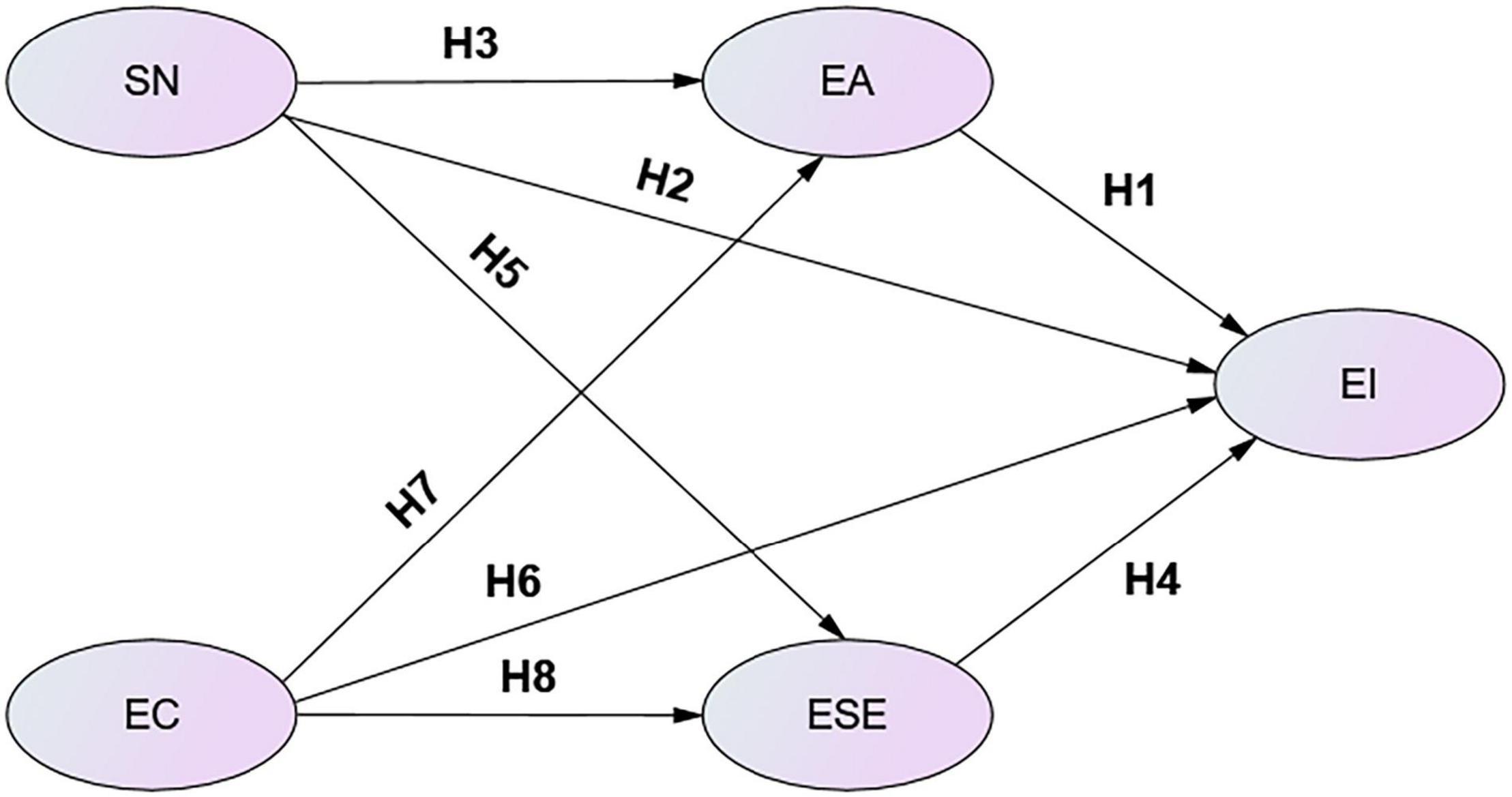
Figure 1. Conceptual framework. SN, subjective norms; EA, entrepreneurial attitude; ESE, entrepreneurial self-efficacy; EI, entrepreneurial intention; EC, emotional competency.
Entrepreneurial Intention
Five question items had been borrowed from the scale by Liñán and Chen (2009) to measure the EI. The major reason for adopting the question items from Liñán and Chen (2009) is that these constructs had confirmed the high reliability with Cronbach’s alpha value of 0.946 such as “My professional goal is to become an entrepreneur” and “I have got the firm intention to start a firm someday” and so forth.
Entrepreneurial Attitude
Similar to EI, the EA is also measured with the help of five questions being borrowed from Liñán and Chen (2009). Furthermore, these constructs also showed high reliability of Cronbach’s alpha of 0.909 such as “Being an entrepreneur implies more advantages than disadvantages to me” and “If I had the opportunity and resources, I’d like to start a firm” and so forth.
Subjective Norms
Three question items were adopted from Kolvereid (1996) and Liñán and Chen (2009) to measure the SN. Their study also confirmed the high reliability of these constructs with Cronbach’s alpha of 0.864 such as “If I decided to create a firm, my closest family would approve of that decision” and “If I decided to create a firm, people who are important to me would approve of that decision” and so forth.
Entrepreneurial Self-Efficacy
Entrepreneurial self-efficacy was assessed through 5 question items borrowed from De Noble et al. (1999) and Liñán (2008). Both research studies had confirmed the high reliability of the constructs (Cronbach’s alpha of 0.931) such as “I can work productively under continuous stress, pressure, and conflict” and “I can originate new ideas and products” and so on.
Emotional Competency
Emotional competency was also evaluated with the help of 3 different question items borrowed from Goleman (1998) and Cherniss and Goleman (2005). Both of the studies indicated the high reliability of the constructs with Cronbach’s alpha of 0.914 such as “I acknowledge the needs of other people to progress, and I like to foster their capabilities” and “I can make use of effective means of persuasion” and so forth.
Results
Descriptive Statistics
Table 2 represents the descriptive statistics of the constructs.
The descriptive statistics of the constructs show that all means/averages, excluding EI which is 3.48, are higher than the midpoint of 3.50, ranging from 3.69 to 3.48. In addition to this, the standard deviations (S.D) range from 0.78 to 0.59. The skew index ranges from –0.27 to –0.64, whereas the kurtosis index ranges from 2.48 to 0.81. The kurtosis and skew indices are acceptable and indicative of univariate normality (Teo et al., 2009). Hence, the research data for this work is assumed to be sufficient for structural equation modeling.
Test of the Measurement Model
Confirmatory factor analysis (CFA) was applied to test the quality of the measurement model. Additionally, the significance of the individual item loadings (t-values) was examined to establish the model fit. The use of fit indices from different categories have been suggested by Hair et al. (2006). The efficiency with which the observed data is reproduced by the proposed model is measured by absolute fit indices. The absolute fit indices are similar to the indices of parsimony except that the former also considers the complexity of the model. Furthermore, the relevance between specific model fit to the alternative baseline model is assessed with the help of incremental fit indices. Several statistical tests, including comparative fit index (CFI), the root mean square error of approximation (RMSEA), χ2 statistic, Tucker-Lewis index (TLI), and standardized root mean residual (SRMR), have been used in this study. The chi-square divided by the degrees of freedom (χ2/df) must not surpass the value of 3 for a model to be considered as a good fit (Carmines and McIver, 1981), as well as both CFI and TLI should both exceed the value of 0.95 (Hu and Bentler, 1999). Hair et al. (2006) asserted that both SRMR and RMSEA should not exceed 0.08 to be considered adequate.
The factor loadings of all items on the constructs in the measurement model are displayed in Table 3. All parameter estimates are significant (p < 0.05) as highlighted by the t-value higher than 1.96 or critical ratio (CR). Additionally, the R2 values are above 0.50 for all variables except EC1 (R2 = 0.41), which indicates that each indicator has explained more than half of the variance in the latent variable. Nunnally and Bernstein (1994) point out that the alpha values, which range from 0.94 to 0.95 are considered high. This shows that there is an internal consistency in the items. Lastly, sufficient model fit for the measurement model was reported (χ2 = 427.321, χ2/df = 2.387, GFI = 0.915, AGFI = 0.890, TLI = 0.963, CFI = 0.968, RMSEA = 0.057, SRMR = 0.033). The adequacy of the measurement model shows that the items are reliable indicators of the hypothesized constructs. As a result, it facilitates the tests of the structural associations in different models to proceed.
Discriminant Validity
Discriminant validity denotes the significant difference or low correlation between the potential variables represented by one or another facet.
The Fornell and Larcker criteria as a measurement, suggested by Fornell and Larcker (1981), is to identify the multicollinearity issues among constructs in this work. The result shows that there are fewer multicollinearity issues among constructs, whereby the square root of AVE (diagonal) is more significant than correlations (off-diagonal) for all constructs in the Table 4 below.
Path Coefficient Analysis
The major purpose of the path coefficient is to assess the significance of explanatory variables toward the dependent variable. This work has proposed the directional hypotheses for H1–H8, where p-value should be less than 0.05 and t-value should be more than 1.657 for hypotheses acceptance as recommended by Hair et al. (2014). Since this criterion was not fulfilled for the three hypotheses of this work, therefore, H2, H5, and H6 were rejected based on Table 5.
The study results highlight that ESE (β = 0.417, p < 0.001) and EA (β = 0.675, p < 0.001) both significantly influence the EI, hence supporting H1 and H4. Moreover, SN had a significant effect on EA (β = 0.102, p < 0.001), and a non-significant effect on and ESE (β = 0.019, p > 0.05) and EI (β = 0.021, p > 0.05). These findings support H3 but turn void the H5 and H2. Lastly, a significant effect of EC was reported on EA (β = 0.772, p < 0.001) and ESE (β = 0.943, p < 0.001). On other hand, EC demonstrated an insignificant effect on EI (β = –0.171, p > 0.05). Thus, it can be implied that the students will perceive themselves as more capable of becoming entrepreneurs as a higher degree of EC leads to a more positive EA. These findings of our study support H7 and H8 but reject H6.
Mediating Testing
The Bootstrap method is an ideal test method to investigate the presence of mediating effect (Preacher and Hayes, 2008). The criterion is when the confidence interval of the estimated indirect effect does not contain 0 then there is a significant mediating effect.
Table 6 demonstrates the test results which confirm that emotional competency affects EI through EA. In other words, it shows that the EA serves as the mediator as there is an insignificant effect of EC on EI, whereas the EC affects the EI through the mediator EA. These results suggest that EI is developed among the students who develop higher EC through positive EA.
Multigroup Analysis
Entrepreneurship has long been seen as a typically male profession, and women have often found the rewards of starting a business to be less attractive (Shinnar et al., 2014; Nowiński et al., 2019). This is because women think that it is difficult to balance the role of female entrepreneur with that of traditional women. Running a business takes so much effort that female entrepreneurs are often unable to care for their families. Following the previous research, we consider it necessary to test whether the proposed model is invariant when applied to male and female samples.
The purpose of this analysis was to assess the invariance in the proposed model being used for both male and female samples. An initial unconstrained model was constructed to examine whether the pattern of factors and items was feasible across the study samples. A multisample procedure with five consequential hypotheses was applied to consider the final model (Byrne et al., 1989). They are as follows: (a) Measurement weights model, male and female students have equal factor loadings on the structural equation model of EI; (b) structural weights model, male and female students have equal path coefficient on the structural equation model of EI; (c) structural covariances model, male and female students have equal factor covariance on the structural equation model of EI; (d) structural residuals model, male and female students have equal latent variable error equation on the structural equation model of EI; and (e) measurement residuals model, male and female students have equal error term of the observed variable on the structural equation model of EI. Each of the above five models needs to be compared with the unconstrained model, respectively.
The comparison and goodness-of-fit indices for all models in the invariance routine are plotted in Tables 7, 8.
Table 7 indicates that the fitting index is sound. Subsequently, Table 8 highlights that the chi-square difference tests of the measurement weights model and structural weights model were insignificant. While, on other hand, the chi-square difference between the unconstrained model and the other three models (measurement residuals model, structural residuals model, and structural covariances model) was significant. Additionally, the incremental fit indices demonstrate that such change supports the differences that are insignificant as shown by a change of 0.01 or less in the fit indexes (Cheung and Rensvold, 2002). Therefore, we concluded in support of the model invariance across the samples of male and female students.
Discussion
The main aim of this work was to find out the major drivers behind the EI of college students. The literature review has proposed EI as one of the determinants of entrepreneurial activities. Additionally, it has been hypothesized that EI is estimated by different independent variables including EC, ESE, SN, and EA. The research model (Figure 1) was tested using structural equation modeling techniques, and the results revealed a good fit for the data. Most of the hypothesized associations among the constructs in the research model were supported, accounting for 80% of the total variance in the EI. In the subsequent paragraphs, the study findings are discussed to address the research questions being raised in the introduction section.
The study findings indicate that ESE and EA have a significant and direct association with the EI. The study results confirms that the Chinese higher vocational college students who have a positive attitude to start and run their own companies have a positive EI, consistent with the studies by Said et al. (2021) and Su et al. (2021). It also justifies that the students from Chinese higher vocational college who believe in their abilities to achieve the set targets in the critical conditions are more inclined to have higher EI as supported by the study from Fernandez-Perez et al. (2019).
Subjective norm did not demonstrate a significant impact on EI. Furthermore, the results suggested that there is no mediating effect of SN on EI through ESE or EA. Contrarily, SN displayed a significant effect on EA. Since most of the students in Chinese vocational college lack social experience and do not constitute an independent personality, their attitude toward entrepreneurship is easily influenced by the people close around them, such as friends and family members. However, it is not mandatory that the students will must change their EI in this manner.
Emotional competency also did not demonstrate a significant impact on EI. This shows that EC completely affects EI through the mediator EA as reported by Huezo-Ponce et al. (2021). It also shows that the EI of students in Chinese higher vocational college is not significantly affected, whereas the EC is well-supported. However, when the students display a positive attitude toward entrepreneurial behavior then EC became an important consideration. Therefore, the colleges should not pass on the entrepreneurial knowledge and skills being required by the students, but should encourage students to obtain more pronounced emotional intelligence.
Finally, a multigroup analysis was conducted to verify the invariance of the proposed model in both male and female samples. It was found that there is no significant difference in EI influencing factors between male and female students.
Our study findings not only contribute to the development of entrepreneurship theories but also extend vital inspiration for entrepreneurship role among Chinese students of higher vocational college. It also supports the practice and training of entrepreneurship education in higher vocational institutions and universities. Hence, this work provides an important framework to understand the EI of the Chinese students by exploring the emotional and cognitive factors and their possible interrelationships. Consequently, this work proposes to achieve a rational balance, particularly in the decisions with emotional dimensions.
Conclusion
This study has explored four major driving factors behind the EI of Chinese students among higher vocational college. This work has put forward research implications for the researchers and educators to understand the major drivers and their antecedents, and how these factors interact to explain the high and low levels of entrepreneurial intent among students. Since, entrepreneurship requires analytical management skills, the EI of the students will increase or at least continue to sustain when universities and other higher educational institutions effectively manage the stated four variables in the competitive learning environment.
Limitation and Future Research
Despite the significant contributions offered by this study, it has some limitations and unaddressed questions. First of all, this work only looked at expected intentions toward expected behavior, not the behavior itself. Therefore, future studies should be designed to cover time from a longer perspective. Secondly, convenience sampling rather than random sampling was used in this study, and all students came from a single province, which may affect the representativeness and universality of the results. In this regard, it is recommended that future research may compare crossregional students from different parts of the same country or different countries to test the hypothesis of the study, which have different cultural, social norms, and academic backgrounds. Finally, the relevant impact of entrepreneurship education is not mentioned in the current research framework. Ni and Ye (2018) studied the EI of students in Secondary vocational schools in China and pointed out that entrepreneurship education can play the role of a booster and further improve their comprehensive quality and lay the foundation for their future career development. There is a positive effect of entrepreneurship education on EI among students from secondary vocational schools in China. Therefore, in future studies, we will add this variable to enrich our research results.
Implications
First, a variety of measures are taken to improve students’ EC. On the one hand, the cultivation of EC is incorporated into the compulsory courses of vocational college students, leading students to understand the inner logic of emotions from multiple perspectives such as sociology and psychology, and master appropriate emotional attitudes and emotional skills; on the other hand, build emotions based on the Internet platform General education courses to overcome the shortcomings of lack of professional resources and narrow coverage of offline courses, so that resources can benefit as many vocational college students as possible. Secondly, vocational colleges and governments should attach great importance to cultivating college students’ EA and ESE, and pay special attention to factors related to EA and ESE. The government and schools can promote the advantages of entrepreneurship through courses, hold entrepreneurial activities, social media, and other channels to create a good entrepreneurial atmosphere, such as propagating to students that entrepreneurship has the advantages of solving employment problems, realizing economic independence, realizing their own values and dreams, and making contributions to the society and economy. In addition, from the perspective of SN, families should also provide higher vocational graduates with greater tolerance and support in terms of entrepreneurship. Through these approaches, students’ EA can be changed from bad to good, so that they can form their EI under the influence of follow-up training guidance and entrepreneurial role models. Finally, the government should create a better entrepreneurial environment for college students, such as establishing social entrepreneurship support projects, providing entrepreneurial funds, and providing free entrepreneurial venues so that college students can easily start their businesses.
Data Availability Statement
The raw data supporting the conclusions of this article will be made available by the authors, without undue reservation.
Author Contributions
XW: conceptualization. XW and YT: data curation. YT: writing original draft, writing, review, and editing. Both authors have read and agreed to the published version of the manuscript.
Conflict of Interest
The authors declare that the research was conducted in the absence of any commercial or financial relationships that could be construed as a potential conflict of interest.
Publisher’s Note
All claims expressed in this article are solely those of the authors and do not necessarily represent those of their affiliated organizations, or those of the publisher, the editors and the reviewers. Any product that may be evaluated in this article, or claim that may be made by its manufacturer, is not guaranteed or endorsed by the publisher.
References
Acuna-Duran, E., Pradenas-Wilson, D., Oyanedel, J. C., and Jalon-Gardella, R. (2021). Entrepreneurial intention and perceived social support from academics-scientists at Chilean Universities. Front. Psychol. 12:682632. doi: 10.3389/fpsyg.2021.682632
Ajzen, I. (1985). “From intentions to actions: a theory of planned behavior,” in Action Control, eds J. Kuhl and J. Beckmann (Berlin: Springer).
Bandura, A. (1978). Self-efficacy: toward a unifying theory of behavioral change. Adv. Behav. Res. Ther. 1, 139–161. doi: 10.1016/0146-6402(78)90002-4
Baron, R. A. (2008). The role of affect in the entrepreneurial process. Acad. Manag. Rev. 33, 328–340.
Bartha, Z., Gubik, A. S., and Bereczk, A. (2018). The social dimension of the entrepreneurial motivation in the central and eastern european countries. Entrepreneurial Bus. Econ. Rev. 7, 9–27. doi: 10.15678/EBER.2019.070101
Bird, B. (1988). Implementing entrepreneurial ideas: the case for intention. Acad. Manag. Rev. 13, 442–453. doi: 10.5465/AMR.1988.4306970
Boubker, O., Arroud, M., and Ouajdouni, A. (2021). Entrepreneurship education versus management students’ entrepreneurial intentions: a PLS-SEM approach. Int. J. Manag. Educ. 19:100450.
Boyd, N. G., and Vozikis, G. S. (1994). The influence of self-efficacy on the development of entrepreneurial intentions and actions. Entrepreneurship Theory Practice 18, 63–77. doi: 10.1177/104225879401800404
Byrne, B. M., Shavelson, R. J., and Muthén, B. (1989). Testing for the equivalence of factor covariance and mean structures: the issue of partial measurement invariance. Psychol. Bull. 105, 456–466. doi: 10.1037/0033-2909.105.3.456
Cai, Y., and Zhao, N. (2014). Analysis of college students’ entrepreneurial intention based on principal component regression method. Higher Educ. Exploration 4, 160–165.
Cardon, M. S., Foo, M. D., Shepherd, D., and Wiklund, J. (2012). Exploring the heart: entrepreneurial emotion is a hot topic. Entrepreneurship Theory Practice 36, 1–10. doi: 10.1111/j.1540-6520.2011.00501.x
Carmines, E. G., and McIver, C. (1981). “Analyzing models with unobserved variables: analysis of covariance structures,” in Social Measurement: Current Issues, eds G. W. Bohrnstedt and E. F. Borgatta (Beverly Hills, CA: Sage Publications, Inc), 65–115.
Cheung, G. W., and Rensvold, R. B. (2002). Evaluating goodness-of-fit indexes for testing measurement invariance. Struct. Equat. Model. 9, 233–255. doi: 10.1207/S15328007SEM0902_5
Chien-Chi, C., Sun, B., Yang, H., Zheng, M., and Li, B. (2020). emotional competency, entrepreneurial self-efficacy, and entrepreneurial intention: a study based on china college students’ social entrepreneurship project. Front. Psychol. 11:547627. doi: 10.3389/fpsyg.2020.547627
De Noble, A. F., Jung, D., and Ehrlich, B. (1999). Entrepreneurial self-efficacy: the development of a measure and its relationship to entrepreneurial intentions and actions. Entrepreneurship Theory Practice 18, 63–77. doi: 10.1186/s12913-016-1423-5
Doanh, D. C., and Bernat, T. (2019). Entrepreneurial self-efficacy and intention among vietnamese students: a meta-analytic path analysis based on the theory of planned behavior. Knowledge-Based Intell. Inform. Eng. Systems (Kes 2019) 159, 2447–2460. doi: 10.1016/j.procs.2019.09.420
Fernandez-Perez, V., Montes-Merino, A., Rodriguez-Ariza, L., and Galicia, P. E. A. (2019). Emotional competencies and cognitive antecedents in shaping student’s entrepreneurial intention: the moderating role of entrepreneurship education. Int. Entrepreneurship Manag. J. 15, 281–305. doi: 10.1007/s11365-017-0438-437
Fornell, C., and Larcker, D. F. (1981). Evaluating structural equation models with unobservable variables and measurement error. J. Market. Res. 18, 39–50.
Hair, J. F., Black, W. C., Babin, B. J., and Anderson, R. E. (2006). Multivariate Data Analysis, 6th Edn. Upper Saddle River: Pearson Prentice Hall.
Hair, J., Hult, G. T. M., Ringle, C., and Sarstedt, M. (2014). A Primer on Partial Least Squares Structural Equation Modeling. Newcastle upon Tyne: Sage.
Hu, L. T., and Bentler, P. M. (1999). Cutoff criteria for fit indexes in covariance structure analysis: conventional criteria versus new alternatives. Struct. Equat. Model. Multidisciplinary J. 6, 1–55. doi: 10.1080/10705519909540118
Huezo-Ponce, L., Fernandez-Perez, V., and Rodriguez-Ariza, L. (2021). Emotional competencies and entrepreneurship: modeling universities. Int. Entrepreneurship Manag. J. 17, 1497–1519. doi: 10.1007/s11365-020-00683-w
Kautonen, T., van Gelderen, M., and Fink, M. (2015). Robustness of the theory of planned behavior in predicting entrepreneurial intentions and actions. Entrepreneurship Theory Practice 39, 655–674. doi: 10.1111/etap.12056
Kolvereid, L. (1996). Prediction of employment status choice intentions. Entrepreneurship Theory Practice 21, 47–58. doi: 10.1177/104225879602100104
Krueger, N. F., Reilly, M. D., and Carsrud, A. L. (2000). Competing models of entrepreneurial intentions. J. Bus. Venturing 15, 411–432.
Liñán, F. (2008). Skill and value perceptions: how do they affect entrepreneurial intentions? Int. Entrepreneurship Manag. J. 4, 257–272.
Liñán, F., and Chen, Y. W. (2009). Development and cross-cultural application of a specific instrument to measure entrepreneurial intentions. Entrepreneurship Theory Practice 33, 593–617. doi: 10.1111/j.1540-6520.2009.00318.x
Lüthje, C., and Franke, N. (2003). The ‘Making’ of an entrepreneur: testing a model of entrepreneurial intent among engineering students at MIT. R D Manag. 33, 135–147. doi: 10.1111/1467-9310.00288
National Bureau of Statistics (2019). National Data (education). Beijing: National Bureau of Statistics.
National Institute Of Education Sciences (2020). 2020 China Vocational Education Quality Annual Report. Beijing: Higher Education Press.
Ni, H., and Ye, Y. (2018). Entrepreneurship education matters: exploring secondary vocational school students’ entrepreneurial intention in China. Asia-Pacific Edu. Res. 27, 409–418. doi: 10.1007/s40299-018-0399-399
Noel, T. W. (2002). Effects of entrepreneurial education on intent to open a business: an exploratory study. J. Entrepreneurship Educ. 5:3.
Nowiński, W., Haddoud, M. Y., Lančarič, D., Egerová, D., and Czeglédi, C. (2019). The impact of entrepreneurship education, entrepreneurial self-efficacy and gender on entrepreneurial intentions of university students in the Visegrad countries. Stud. Higher Educ. 44, 361–379. doi: 10.1080/03075079.2017.1365359
Padilla-Meléndez, A., Fernandez-Gamez, M. A., and Molina-Gomez, J. (2014). Feeling the risks: effects of the development of emotional competencys with outdoor training on the entrepreneurial intent of university students. Int. Entrepreneurship Manag. J. 10, 861–884. doi: 10.1007/s11365-014-0310-y
Pejic, B. M., Aleksic, A., and Marjana, M. S. (2018). Examining determinants of entrepreneurial intentions in Slovenia: applying the theory of planned behaviour and an innovative cognitive style. Econ. Research-Ekonomska Istrazivanja 31, 1453–1471. doi: 10.1080/1331677x.2018.1478321
Preacher, K. J., and Hayes, A. F. (2008). Asymptotic and resampling strategies for assessing and comparing indirect effects in multiple mediator models. Behav. Res. Methods 40, 879–891. doi: 10.3758/brm.40.3.879
Qian, Y.-H. (2007). Research on the influencing factors of entrepreneurial intention. J. Zhejiang University (Humanities and Social Sciences Edition) 37, 144–152.
Rasli, A., Khan, S.-U.-R., Maleki Far, S., and Jabeen, S. (2013). Factors affecting entrepreneurial intention among graduate students of universiti teknologi Malaysia. Int. J. Bus. Soc. Sci. 4, 182–188.
Renmin University of China (2020). 2020 Chinese University Student Entrepreneurship Report. Beijing: China Renmin University Press.
Said, N., Uthamaputhran, S., Zulkiffli, W. F., Hong, L. M., and Hong, C. (2021). “The mediating efeects of entrepreneurial education towards antecedents of entrepreneurial intention among undergraduate students,” in The Importance of New Technologies and Entrepreneurship in Business Development: In The Context of Economic Diversity in Developing Countries, (Cham: Springer).
Shinnar, R. S., Hsu, D. K., and Powell, B. C. (2014). Self-efficacy, entrepreneurial intentions, and gender: assessing the impact of entrepreneurship education longitudinally. Int. J. Manag. Educ. 12, 561–570. doi: 10.1016/j.ijme.2014.09.005
Su, Y. S., Zhu, Z. R., Chen, J. W., Jin, Y. Q., Wang, T., Lin, C. L., et al. (2021). Factors influencing entrepreneurial intention of university students in China: integrating the perceived university support and theory of planned behavior. Sustainability 13:4519. doi: 10.3390/su13084519
Tehseen, S., and Haider, S. A. (2021). Impact of Universities’ partnerships on students’ sustainable entrepreneurship intentions: a comparative study. Sustainability 13:5025. doi: 10.3390/su13095025
Teo, T., Lee, C. B., Chai, C. S., and Wong, S. L. (2009). Assessing the intention to use technology among pre-service teachers in Singapore and Malaysia: a multigroup invariance analysis of the Technology Acceptance Model (TAM). Comp. Educ. 53, 1000–1009. doi: 10.1016/j.compedu.2009.05.017
Thompson, E. R. (2009). Individual entrepreneurial intent: construct clarification and development of an internationally reliable metric. Entrepreneurship: Theory Practice 33, 669–694. doi: 10.1111/j.1540-6520.2009.00321.x
Utami, C. W. (2017). Attitude, subjective norms, perceived behavior, entrepreneurship education and self-efficacy toward entrepreneurial intention university student in Indonesia. Eur. Res. Stud. J. 20, 475–495.
Keywords: entrepreneurial intention, entrepreneurial self-efficacy, emotional competencies, subjective norms, entrepreneurial attitude, higher vocational college students
Citation: Wu X and Tian Y (2022) Predictors of Entrepreneurship Intention Among Students in Vocational Colleges: A Structural Equation Modeling Approach. Front. Psychol. 12:797790. doi: 10.3389/fpsyg.2021.797790
Received: 19 October 2021; Accepted: 06 December 2021;
Published: 12 January 2022.
Edited by:
Shih-Chih Chen, National Kaohsiung University of Science and Technology, TaiwanReviewed by:
Beyfen Lee, Chung Hwa University of Medical Technology, TaiwanYuan Tang, Sichuan University of Science and Engineering, China
Ari Saptono, Jakarta State University, Indonesia
Copyright © 2022 Wu and Tian. This is an open-access article distributed under the terms of the Creative Commons Attribution License (CC BY). The use, distribution or reproduction in other forums is permitted, provided the original author(s) and the copyright owner(s) are credited and that the original publication in this journal is cited, in accordance with accepted academic practice. No use, distribution or reproduction is permitted which does not comply with these terms.
*Correspondence: Xueshi Wu, MTgwNzAwMzMwMTVAMTYzLmNvbQ==
 Xueshi Wu
Xueshi Wu Yumi Tian
Yumi Tian